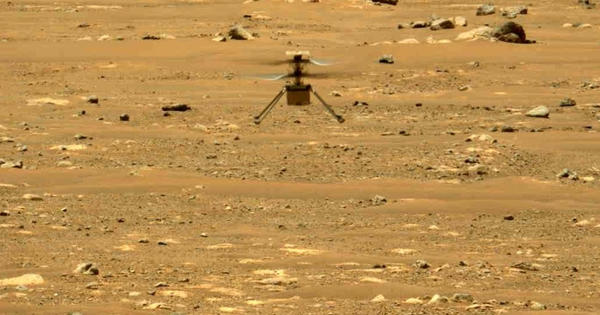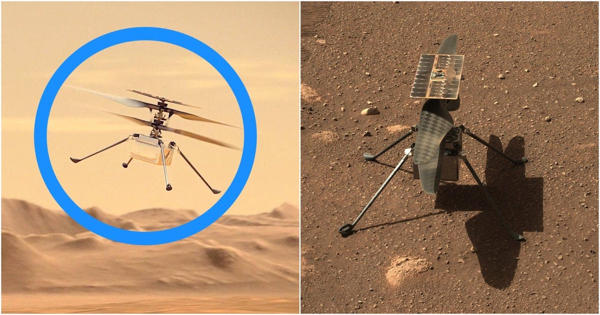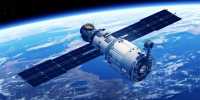The Ingenuity drone was in the air for less than a minute, but Nasa is celebrating what it believes to be the first powered, controlled flight by an aircraft on another planet. Confirmation came from a Mars satellite that relayed the chopper’s data back to Earth.
The victory was heralded as a Wright Brothers moment. The mini 4-pound (1.8-kilogram) copter even carried a scrap of wing fabric from the Wright Flyer, which made similar history in 1903 at Kitty Hawk, North Carolina. It was a short hop—39 seconds and 10 feet (3 meters)—but it hit all the major milestones.
“Goosebumps. It appears to be exactly as we had tested, “During a later briefing, project manager MiMi Aung said as she watched the flight video.” It was an absolutely stunning flight. I don’t think I’ll ever be able to stop watching it over and over again.”
NASA’s experimental helicopter Ingenuity rose into the thin air above the dusty red surface of Mars on Monday, achieving the first powered flight by an aircraft on another planet.
After receiving data and images from the Perseverance rover, flight controllers at NASA’s Jet Propulsion Laboratory in California declared a success. Ingenuity rode Perseverance to Mars, clinging to the rover’s belly when it landed in an ancient river delta in February. The $85 million helicopter demonstration was regarded as a high risk, but a high reward.
Scientists cheered the news from all over the world, including space, and the White House congratulated them. “We now have a whole new way to explore the alien terrain in our solar system,” Nottingham Trent University astronomer Daniel Brown said from England.
This first test flight—with more to come by Ingenuity, the next as early as Thursday—holds a lot of promise, according to Brown. Future helicopters could act as scouts for rovers and, eventually, astronauts in difficult, dangerous environments.
Ingenuity has added a new dimension to planetary exploration, “freeing us from the surface now and forever,” according to JPL director Michael Watkins. Ground controllers had to wait more than three agonizing hours to learn whether the preprogrammed flight 178 million miles (287 million kilometers) away had succeeded. The first attempt had been postponed for a week due to a software glitch.

When the news was finally delivered, the operations center erupted in applause, cheers, and laughter. More came after the first black and white photo from Ingenuity, which showed the helicopter’s shadow as it hovered above Mars’ surface. “In the shadow of greatness, the first flight of the #MarsHelicopter on another world has been completed!” Victor Glover, a NASA astronaut, tweeted from the International Space Station.
Perseverance, “the best host little Ingenuity could ever hope for,” Aung said in thanking everyone, then captured a stunning color video of the copter’s clean landing. The helicopter hovered for 30 seconds at its intended altitude of 10 feet (3 meters) and flew for 39 seconds, more than three times longer than the Wright Flyer’s first successful flight, which lasted only 12 seconds on December 17, 1903.
All of this required the helicopter’s twin, counter-rotating rotor blades to spin at 2,500 revolutions per minute—five times faster than on Earth. Engineers had to build a helicopter light enough—with blades spinning fast enough—to generate this otherworldly lift in an atmosphere that was only 1% the density of Earth’s. The Martian wind was relatively light on Monday, ranging between 4 and 14 miles per hour (7 kph to 22 kph).
Ingenuity, a spindly four-legged chopper that took more than six years to create, stands only 19 inches (49 centimeters) tall. Its fuselage, which houses all of the batteries, heaters, and sensors, is about the size of a tissue box. The largest components are the carbon-fiber, foam-filled rotors: Each pair is 4 feet (1.2 meters) long from tip to tip.
Ingenuity had to be strong enough to withstand the Martian wind, and it is topped with a solar panel for charging the batteries, which is essential for surviving the minus-130 degree Fahrenheit (minus-90 degree Celsius) Martian nights.
For Ingenuity’s airfield, NASA chose a flat, relatively rock-free area. Following the area’s success on Monday, NASA named it after the Wright brothers. “While these two iconic moments in aviation history may have been separated by time and… million miles of space, they are now inextricably linked,” NASA’s science missions chief Thomas Zurbuchen said. From the moment it debuted with Perseverance last July, the small chopper with a big job drew attention. Over the weekend, Arnold Schwarzenegger joined in the fun, rooting for Ingenuity. In a tweeted video, he yelled, “Get to the chopper!” a line from his 1987 sci-fi film “Predator.”
Up to five increasingly ambitious flights are planned, and they could pave the way for a fleet of Martian drones to provide aerial views, transport packages, and serve as lookouts for human crews in the coming decades. On Earth, the technology could allow helicopters to reach new heights, allowing them to navigate the Himalayas more easily.
The Ingenuity team has until the beginning of May to complete the test flights so that the rover can focus on its main mission: collecting rock samples that may contain evidence of past Martian life for return to Earth a decade later.
The team intends to push the helicopter to its limits, possibly wrecking it and leaving it to rest in place forever after sending data back home. Perseverance will keep an eye on Ingenuity until then. Percy and Ginny are nicknames given to flight engineers. “Big sister is watching,” said Elsa Jensen of Malin Space Science Systems, the rover’s lead camera operator.















